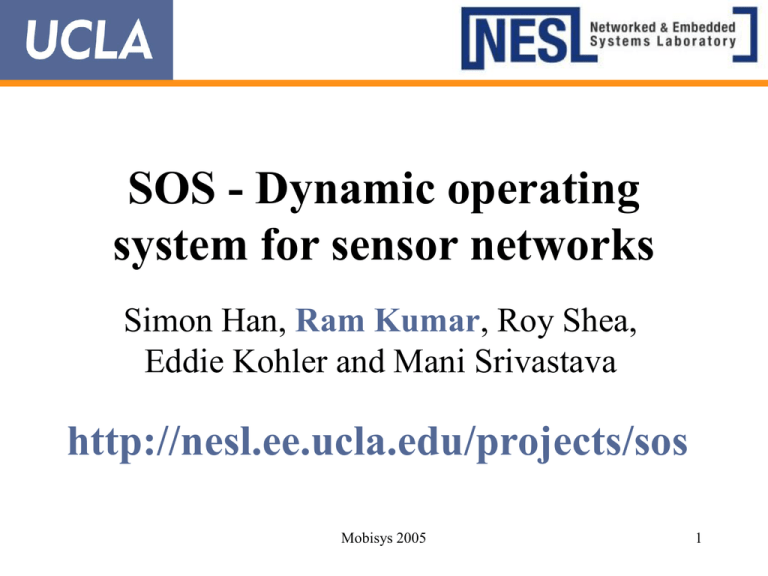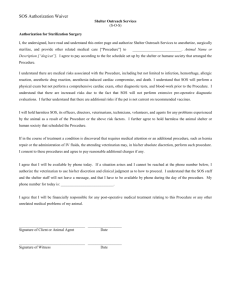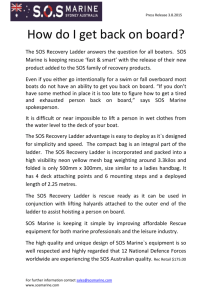SOS
advertisement

SOS - Dynamic operating
system for sensor networks
Simon Han, Ram Kumar, Roy Shea,
Eddie Kohler and Mani Srivastava
http://nesl.ee.ucla.edu/projects/sos
Mobisys 2005
1
Embedded Sensor Networks
Habitat Monitoring
Emergency Response Structural Monitoring
Resource Constrained Nodes
Design Goal - Long lifetime
Large scale ad-hoc networks
Mobisys 2005
2
Re-tasking sensor networks
Re-tasking a deployed network
Data Gathering
Bird Localization
Fire Emergency
Requires in-situ re-programming
Mobisys 2005
3
Re-programming Challenges
Severe resource constraints on nodes
4 KB RAM, 128 KB FLASH Instruction Memory, 2 AA
batteries
Avoiding crashes
Unattended operation - Crashed node is useless
No architecture support for protection e.g. MMU
Balancing flexible and concise updates
Update applications, services and drivers
Energy efficient distribution and storage
Mobisys 2005
4
Sensor Network OS State of the Art
TinyOS - Application specific OS
Application, OS and drivers are NesC components
Select app components, statically analyze and optimize
Extensive set of well-tuned components
Supports full binary upgrades
Maté - Application specific Virtual Machine
Domain specific bytecode interpreter on TinyOS
Programs are small scripts containing VM instructions
Better suited for application specific tuning
Interpreter updates require fallback to TinyOS
Mobisys 2005
5
Towards general purpose sensor OS
TinyOS and Maté
Application and OS are tightly linked
Design Goal: An application independent sensor OS
Independently written & deployed apps run on one network
Towards traditional kernel space/user space programming
model
Re-programming via binary modules
Risk: Lose safety provided by static analysis or dynamic
interpreter
Design Challenge
Provide general purpose OS semantics on resource
constrained embedded sensor nodes
Mobisys 2005
6
SOS Operating System
Dynamic operating system for sensor networks
Kernel and dynamically-loadable modules
Ported to Mica2, MicaZ, XYZ and Telos
Convenient, yet compact, kernel interface
Dynamic function links - 10 bytes overhead/function
Safety features through run-time checks
Type safe linkage, Memory overflow checks
Performance
No worse than TinyOS for real world applications
Mobisys 2005
7
SOS Application
Navigation
Motor Controller
Obstacle Detection
Localization
Ragobot - Mobile Sensor Node Software
All modules are dynamically loadable
Install new robot behaviors by updating navigation module
Future ragobot versions will support hot-swap of
peripherals
SOS provides automatic driver updates
Mobisys 2005
8
Contributions
Framework for binary modular re-programming
Dynamic linking
Message Passing
Dynamic Memory
Inexpensive safety mechanisms for an embedded OS
Type safe linking
Monitored memory allocation
Garbage collecting scheduler and error stub
Watchdog mechanism
General purpose OS semantics on sensor nodes
Mobisys 2005
9
Outline
Introduction
SOS Architecture
Evaluation
Conclusion
Mobisys 2005
10
Architecture Overview
Tree Routing
Module
Data Collector
Application
Photo-sensor
Dynamically
Module
Loaded modules
Static SOS Kernel
Dynamic
Memory
Message
Scheduler
Dynamic
Linker
Kernel
Components
Sensor
Manager
Messaging
I/O
System
Timer
SOS
Services
Device
Drivers
* - Drivers adapted from TinyOS for Mica2
Radio*
I2C
Mobisys 2005
ADC*
11
SOS Overview
Programmed entirely in C
Co-operatively scheduled system
Event-driven programming model
System provides no memory protection
Mobisys 2005
12
Designing Safety Features
Dynamically evolving system
Unspecified behavior resulting from transient states
Goals
Ensure system integrity
Graceful recovery from failures
Design
Minimal set of run-time checks
Designed for low resource utilization
Does not cover all failure modes
Mobisys 2005
13
Installing Dynamic Modules
Modules implement specific function or
task
FLASH Layout
Position independent binary
Loader stores module at arbitrary
program memory location
Minimal state maintenance
8 bytes per module
Stores module identity and version
Mobisys 2005
SOS Kernel
<Empty Space>
Module 1
<Empty Space>
Bootloader
14
Inter-module Communication
Module A
Dynamic
Linking
Module B
Module Function
Pointer Table
Module A
Message
Passing
Module B
Message
Buffer
Dynamic Linking
Synchronous communication
Blocking function calls that
return promptly
Message Passing
Asynchronous communication
Long running operations
Mobisys 2005
15
Dynamic Linking Overview
Goals
Low latency inter-module communication comparable
to direct function calls
Functional interface is convenient to program
Challenges
Safety features to address missing and updated
modules
Constraints
Minimize RAM usage
Mobisys 2005
16
Dynamic Linking Design
Publish functions for the other parts of system to use
Subscribe to functions supplied by other modules
Indirection provides support for safety features
Dynamic function call overhead
21 cycles compared to 4 cycles for direct function call
Publish
Subscribe
Module B
Module A
<foo, B, FOO_ID, Type>
Function Control Block Table (FCB)
Mobisys 2005
17
Dynamic Linking Safety Features
Module A
Module B
<foo, B, FOO_ID, Type>
Function Control Block Table
Error Stub
Run-time Type Checking
Module updates can introduce new function prototype
Type mismatches are detected, error flag is raised
Mobisys 2005
18
Message Passing System
Data Collector
Application
Inter-module
communication
Kernel - module
communication
System
Timer
System Scheduler
Tree Routing
Module
MESSAGE
<Dest. Addr>
<Dest. Mod. Id>
<Message Type>
<Payload> …
Scheduler looks up handler of destination module
Handler performs long operations on message payload
Mobisys 2005
19
Messaging Safety Features
High priority messaging
Signal timing sensitive events (For e.g. hardware interrupts)
Prevent interrupt chaining into the modules
Concurrency management by kernel
Eliminates race conditions in modules
Watchdog support
Co-operatively scheduled system
Long running message handlers trigger watchdog reboot
Kernel terminates execution of the buggy module
Mobisys 2005
20
Module-Kernel Communication
System Call
System
Jump table
Data Collector Module
SOS
Kernel
HW specific API
System Messages
Priority
Scheduler
Interrupt Service
Hardware
Kernel services available as system calls
Jump table redirects system calls to handlers
Update kernel independent of modules
System Call Overhead - 12 clock cycles
Mobisys 2005
21
Dynamic Memory Allocation
Need to allocate module state at run-time
Design Choice - Fixed-partition allocation
Performance - Constant low allocation time (69 cycles)
Resources - 1 byte overhead per block, 52 blocks
SOS provides memory safety features
Guard bytes detect memory overflow
Ownership tagging to track buggy modules
Guard Byte
16 byte blocks
32 byte blocks
Mobisys 2005
128 byte blocks
22
Garbage Collection
Memory leakage problem
Garbage collection on failed message delivery
Destination module needs to signal ownership
Use the return code of the message handler
SOS_OK - Kernel frees the dynamic memory
SOS_TAKEN - Destination module owns memory
Module A
Message Passing
Module B
Message
Payload
Dynamic
Memory
Mobisys 2005
23
Outline
Introduction
SOS Architecture
Evaluation
Conclusion
Mobisys 2005
24
Evaluation
Design Goal
Provide general purpose OS semantics
Low resource utilization
Hypothesis
Performance no worse TinyOS
Update cost closer to Maté
Experiment Setup
Surge data collection and tree routing on 3 hop network
Low duty cycle application
Mica2 motes: AVR 8-bit microcontroller
Mobisys 2005
25
Application Performance Comparison
Application performance is nearly identical for
TinyOS, SOS and Mate
Packet Delivery Ratio
Data Transfer Delay
Mobisys 2005
26
Performance Overhead
Active Time (%)
TinyOS
SOS
Maté
4.58%
4.64%
5.13%
29.94
30.02
Average Power(mW) 29.92
CPU Active Time - Metric to measure OS overhead
Measured by profiling Surge for 1 min. on real nodes
Averaged over 20 experiments for each system
SOS has 1% overhead relative to TinyOS
Surge has minimal application level processing (“worst” case OS
overhead)
Insignificant variation of average power consumption
Surge application has a very low CPU utilization
System level energy: E(CPU) << E(Radio)
Duty Cycling - Idle energy dominates over active energy
Mobisys 2005
27
Update Costs
Method
Energy
Entire binary upgrade (TinyOS) 784.14 mJ
Cost
High
Modular binary upgrade (SOS)
Virtual Machine scripts (Maté)
Moderate
Low
12.25 mJ
0.34 mJ
Re-programming cost involves
Communication Energy - Transfer the new code
Storage Energy - Write the code to RAM/FLASH etc.
Impact on system level energy
Depends significantly upon frequency of updates
Difference in update cost amortized over the interval between updates
Idle energy in the interval between updates dominates
Idle energy consumption does not depend on the OS
Mobisys 2005
28
Lessons Learnt
Focus on duty cycling all parts of the system
Standardize the API for power management of peripherals
Performance optimization of the CPU is secondary
Account for update energy and frequency
Choose an OS based on the features it provides
SOS - Flexibility of general purpose OS semantics
TinyOS - Full system static analysis
Mate VM - Efficient scripting interface
Mobisys 2005
29
Summary
SOS enables dynamic binary modular upgrades
Design choices minimize resource utilization
Run-time checks for safe code execution
Ported to AVR, ARM, TI MSP
Users at UCLA, Yale, Notre Dame, Harvey Mudd …
Mobisys 2005
30
Future Work
New models for application development
Independent re-usable loadable binary modules
Hierarchy of re-configuration
Maté VM ported to SOS - Extensible virtual machines
Upgrade SOS kernel using TinyOS whole image technique
Staged checkers
Combination of static and run-time checks for code safety
FLASH wear and tear management using SOS
Mobisys 2005
31
Questions ?
THANK YOU !
Check out SOS at
http://nesl.ee.ucla.edu/projects/sos
Mobisys 2005
32
Extra Slides
Mobisys 2005
33
Programming
Programmed in C
Function Registration
char tmp_string = {'C', 'v', 'v', 0};
ker_register_fn(TREE_ROUTING_PID,
MOD_GET_HDR_SIZE,
tmp_string,(fn_ptr_t)tr_get_header_size);
Mobisys 2005
34
Memory Footprint
Platform
ROM
RAM
SOS Core
30716 B 1255 B
(Dynamic Memory Pool)
1536 B
TinyOS with Deluge
21132 B
Bombilla VM
39746 B 3196 B
Mobisys 2005
597 B
35
Micro Benchmarks
Communication Method
Clock Cycles
Posting a message
252
Dispatch message
310
Call to a published dynamic function 21
Call using system jump table
12
Direct function call
4
Mobisys 2005
36
Re-programming Cost
Update Cost
(Transport + Storage)
Entire Image
Modular Binary
Differential
Binary
Patching
VM Scripts
Parameter Changes
Flexibility
Mobisys 2005
37
SOS Applications
Ragobot - Mobile Sensor Node
Dynamically installing new
behavior modules on ragobot
Building Automation
Remote operation and management
of the sensor network infrastructure
Mobile agent applications and a lot more …
Mobisys 2005
38






